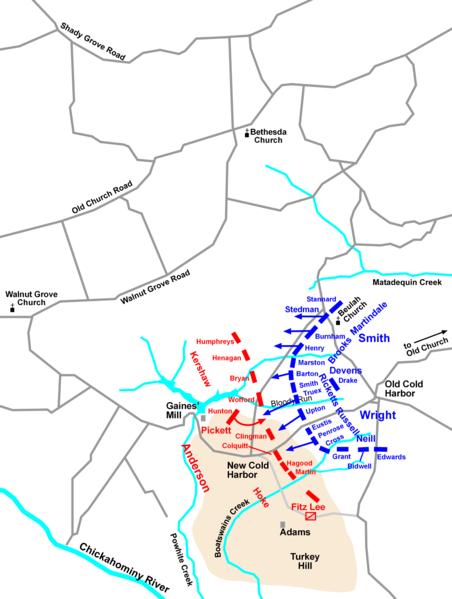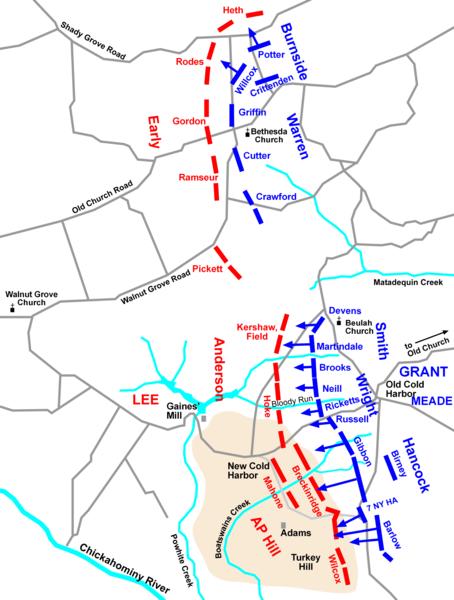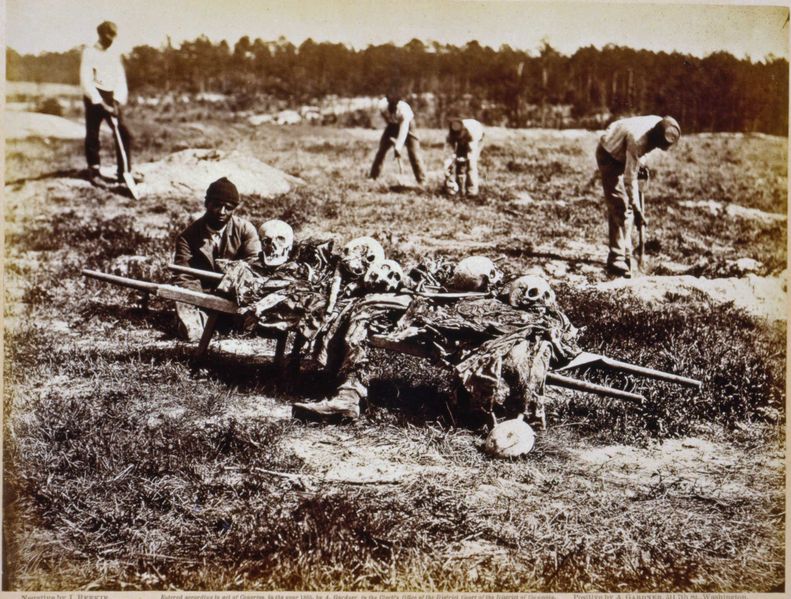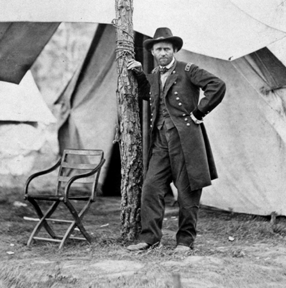|
Battle of Cold Harbor Maps
Cold Harbor Civil War Battlefield Maps
Battle of Cold Harbor Maps
Cold Harbor Civil War Battlefield Maps





(Right) General Ulysses
S. Grant at Cold Harbor Battlefield
Recommended Reading: The Battlefield
of Cold Harbor, Hanover County, Virginia, 1864 (Map). Review: The site of Robert E. Lee and his army of Northern Virginia's last Civil War Victory is one of astonishment, battlefield courage, and horrific
carnage… This work includes the most complete, accurate and detailed maps of the battle of Cold
Harbor ever published. Watercolor and colored pencil map showing farms, mills, entrenchments, watercourses, woods,
fields and residences are all meticulously detailed and scaled to perfection. Continued below...
The reverse side includes an account of Union mapping at Cold Harbor; full color reproduction of the Army
of the Potomac’s Overland Campaign theater map; and photographs of two prominent Union topographical engineers, W. H.
Paine and W. A. Roebling. A welcome addition to every Civil War buff’s library as well as the individual that appreciates
detailed topographical maps. AWARDED FIVE STARS by americancivilwarhistory.org
Recommended Reading: Not War But
Murder: Cold Harbor 1864. Library Journal: On June 3, 1864, the Union Second, Sixth, and Eighteenth Corps
assaulted Confederate breastworks at Cold Harbor outside Richmond, VA. The resulting bloodbath amounted to U.S. Grant's worst defeat and "Bobby" Lee's final
great victory. In his latest book, native Virginian and Baltimore Sun correspondent Furgurson
(Chancellorsville, 1863) vividly retells the well-known story of how the friction between Grant and his insecure direct subordinate,
George Meade, poisoned the Army of the Potomac's whole chain of command. Continued below…
By contrast,
he depicts Lee as a commander beset by poor health and impossible logistical problems who brilliantly deployed his meager
forces and soundly thrashed his overconfident adversary, thereby saving the rebel capital and extending an unwinnable war
by nearly a year. The book is rich in word pictures and engaging anecdotes. Furgurson considers the wounded that were left
to suffer with the dead between the lines while Lee and Grant quibble over protocols of recovery; the disastrous affect of
poor maps and impassable terrain on the Federal assault; and Grant's immediate need to bring Lincoln a battlefield victory
before the 1864 presidential election. Furgurson's contribution is his evocative retelling of a great American military tragedy.
Recommended Reading: Cold Harbor: Grant and
Lee, May 26-June 3, 1864, by Gordon C. Rhea (Hardcover). Description: In his gripping volume on the spring 1864 Overland campaign--which pitted Ulysses S. Grant
against Robert E. Lee for the first time in the Civil War--Gordon Rhea vividly re-creates the battles and maneuvers from the
North Anna stalemate through the Cold Harbor offensive. Rhea's tenacious research elicits
stunning new facts from the records of a phase oddly ignored or mythologized by historians. The Cold Harbor of these pages
differs sharply from the Cold Harbor of popular lore. We see Grant, in one of his most brilliant
moves, pull his army across the North Anna
River and steal a march on Lee. In response, Lee sets up a strong defensive
line along Totopotomoy Creek, and the battles spark across woods and fields northeast of Richmond.
Continued below…
Their back
to the Chickahominy River and on their last legs,
the rebel troops defiantly face an army-wide assault ordered by Grant that extends over three hellish days. Rhea gives a surprising
new interpretation of the famous battle that left seven thousand Union casualties and only fifteen hundred Confederate dead
or wounded. Here, Grant is not a callous butcher, and Lee does not wage a perfect fight. Every imaginable primary source has
been exhausted to unravel the strategies, mistakes, gambles, and problems with subordinates that preoccupied two exquisitely
matched minds. In COLD HARBOR,
Rhea separates fact from fiction in a charged, evocative narrative. He leaves readers under a moonless sky, Grant pondering
the eastward course of the James River fifteen miles south of the encamped armies. About
the Author: Gordon Rhea is the author of three previous books, a winner of the Fletcher Pratt Literary Award, a frequent lecturer
throughout the country on military history, and a practicing attorney.
Recommended Reading: Bloody Roads South:
The Wilderness to Cold Harbor, May-June 1864, by Noah Andre Trudeau. Description: "Nobody has brought together in one volume so many eyewitness accounts
from both sides."-Civil War History Winner of the Fletcher Pratt Award. In this authoritative chronicle of the great 1864
Overland Campaign in Virginia, Noah Andre Trudeau vividly re-creates the brutal forty days that marked the beginning of the
end of the Civil War. In riveting detail Trudeau traces the carnage from the initial battles in Virginia's
Wilderness to the gruesome hand-to-hand combat at Spotsylvania's "Bloody Angle," to the ingenious trap laid by Lee at the
North Anna River,
to the killing ground of Cold Harbor. Through fascinating eyewitness accounts, he relates
the human stories behind this epic saga. Continued below…
Common soldiers struggle to find the words to describe the agony of their comrades, incredible tales
of individual valor, their own mortality. Also recounting their experiences are the women who nursed these soldiers and black
troops who were getting their first taste of battle. The raw vitality of battle sketches by Edwin Forbes and Alfred R. Waud
complement the words of the participants. PRAISE FOR THE BOOK: "Bloody Roads South is a powerful and eloquent narrative of
the costliest, most violent campaign of the Civil War. Grant vs. Lee in the Wilderness, at Spotsylvania, and at Cold Harbor has never
been told better."-Stephen W. Sears, author of The Landscape Turned Red. About the Author: Noah Andre Trudeau is an executive
producer for cultural programs at National Public Radio in Washington,
D.C. He is the author of Out of the Storm: The End of the Civil War, April-June
1865 and The Last Citadel: Petersburg, Virginia,
June 1864-April 1865.
Recommended Reading: Trench Warfare under Grant and Lee: Field Fortifications
in the Overland Campaign (Civil War America)
(Hardcover) (The University of North
Carolina Press) (September 5, 2007). Description: In the study of field fortifications in the Civil War that began with Field Armies and Fortifications
in the Civil War, Hess turns to the 1864 Overland campaign to cover battles from the Wilderness to Cold
Harbor. Continued below...
Drawing on
meticulous research in primary sources and careful examination of trench remnants at the Wilderness, Spotsylvania, North Anna,
Cold Harbor, and Bermuda Hundred, Hess describes Union and Confederate earthworks and how Grant and Lee used them in this new era of field
entrenchments.
Recommended Reading: Field Armies and Fortifications in the Civil War: The Eastern Campaigns,
1861-1864 (Civil War America)
(Hardcover). Description: The eastern campaigns of
the Civil War involved the widespread use of field fortifications, from Big Bethel and the Peninsula to Chancellorsville,
Gettysburg, Charleston, and
Mine Run. While many of these fortifications were meant to last only as long as the battle, Earl J. Hess argues that their
history is deeply significant. The Civil War saw more use of fieldworks than did any previous conflict in Western history.
Hess studies the use of fortifications by tracing the campaigns of the Army of the Potomac
and the Army of Northern Virginia from April 1861 to April 1864. Continued below...
He considers
the role of field fortifications in the defense of cities, river crossings, and railroads and in numerous battles. Blending
technical aspects of construction with operational history, Hess demonstrates the crucial role these earthworks played in
the success or failure of field armies. He also argues that the development of trench warfare in 1864 resulted from the shock
of battle and the continued presence of the enemy within striking distance, not simply from the use of the rifle-musket, as
historians have previously asserted. Based on fieldwork
at 300 battle sites and extensive research in official reports, letters, diaries, and archaeological studies, this book should
become an indispensable reference for Civil War historians.

|

